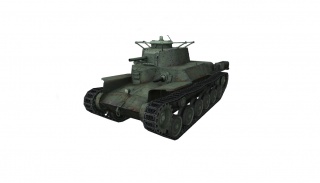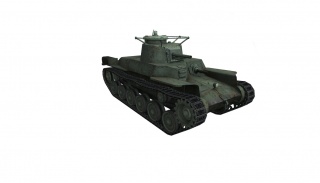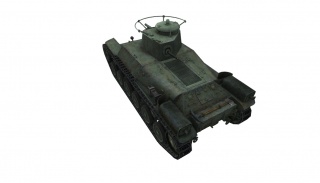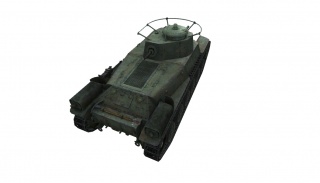Type 2597 Chi-Ha

|
Article requires additional modification The design and/or content of this article do not conform to wiki standards. Missing Content
|
Type 2597 Chi-Ha
Mouse over "
| 42,000 |
| 40585 HP Hit Points |
| 15.04/15.98.37/18 t Weight Limit |
- 전차장
- 포수 (장전수)
- 조종수
- 무전수
| 170240 hp Engine Power |
| 40/15 km/h Speed Limit |
| 3032 deg/s Traverse |
| 11.328.67 hp/t Power/Wt Ratio |
| NoNo Pivot |
| // mm Hull Armor |
| 35/25/2535/25/25 mm Turret Armor |
AP/HEAT/HE
AP/APCR/HE Shells |
| 75/75/9570/70/90 HP Damage |
| 30/55/2881/130/25 mm Penetration |
|
20 r/m ▲
20 r/m Standard Gun ▲ Rate of Fire Standard Gun |
|
1500 ▲
Standard Gun
▼
Standard Gun
▲
1400 Standard Gun ▲
Standard Gun
▼
Standard Gun
▲ Damage Per Minute Standard Gun |
|
0.46 m ▲
0.44 m With 50% Crew: 0.57 m ▲ Accuracy With 50% Crew: 0.545 m |
| 2.3 s 2.3 s Aim time |
| 3030 deg/s Turret Traverse |
| 360° Gun Arc |
| -9°/+20°-15°/+20° Elevation Arc |
| 210180 rounds Ammo Capacity |
| 1515 % Chance of Fire |
| 310 m 330 m View Range |
| 350 m 550 m Signal Range |
III
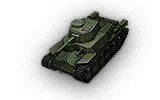
42000
The Type 2597 Chi-Ha is a Chinese tier 3 light tank.
미쓰비시 중공업이 1935년부터 1937년 사이에 개발하였다. 1938년부터 1942년까지 양산되었으며 양산 마지막 2년간은 개량형인 Shinhoto Chi-Ha도 함께 생산되었다. 두 기종 모두 1,220대가 생산되어 중국에 주둔한 일본군이 대량으로 사용하였다. 일본의 항복 이후 이 전차는 1946년 중국 2차 국공내전에서 중국 인민 해방군과 국민당군 양쪽 모두 운용하였다.
The top gun, 47 mm Gun Type 1, features good damage for its tier, excellent penetration (giving you a chance against some tier 5 tanks) and good rate of fire. Unfortunately, the tank is not suited for solo scouting due to its poor acceleration and bad handling, and should be used as support whenever facing tier 5 tanks. In lower tier matches, is is able to directly fight more effectively. AMX 40`s are no challenge for the 47 mm. The slope of the front armor is good enough to bounce some shots. All in all, it is a great tank when fully upgraded, however the research cost of the second turret and final gun outweigh the cost to research the M5A1, so many people play this tank completely stock for the entire time they own it, since you do not need to research any modules on your way to the M5A1.
The Type 2597 Chi-Ha leads to the SU-76G FT, and the M5A1 Stuart.
Modules / Available Equipment and Consumables
Modules

주포
| 단계 | 주포 | 평균 관통력 (mm) | 연사력 | 100m에서의 분산도 | 조준 시간 | 일반 경험치 | 중량 (톤) | 가격, | |
|---|---|---|---|---|---|---|---|---|---|
| II | 57 mm Gun Type 97 | 30/55/28 | 75/75/95 | 20 | 0.46 | 2.3 | 0 | 150 | 2000 |
| II | 45 mm 20K | 51/88/23 | 47/47/62 | 26.09 | 0.46 | 1.7 | 125 | 313 | 2530 |
| IV | 47 mm Gun Type 1 | 81/130/25 | 70/70/90 | 20 | 0.44 | 2.3 | 1200 | 411 | 21000 |

엔진
| 단계 | 엔진 | 엔진 출력 (마력) | 충돌 시 화재 발생 확률 | 일반 경험치 | 중량 (톤) | 가격, |
|---|---|---|---|---|---|---|
| III | Mitsubishi Type 97 | 170 | 15 | 0 | 650 | 5000 |
| IV | Type 100 V-12 W | 200 | 15 | 700 | 630 | 8600 |
| IV | Type 100 V-12 A | 240 | 15 | 850 | 630 | 10500 |

현가장치
| 단계 | 현가장치 | 한계 중량 | 회전 속도 (도/초) | 일반 경험치 | 중량 (톤) | 가격, |
|---|---|---|---|---|---|---|
| II | Type 97 | 15.9 | 30 | 0 | 5000 | 1270 |
| III | Type 97-Kai | 18 | 32 | 330 | 5000 | 1850 |

무전기
| 단계 | 무전기 | 통신 범위 (m) | 일반 경험치 | 중량 (톤) | 가격, |
|---|---|---|---|---|---|
| IV | Type 94 Hei | 350 | 0 | 90 | 180 |
| VI | Type 96 Bo | 425 | 1400 | 50 | 14000 |
| VIII | Type 3 Otsu | 550 | 4000 | 240 | 22000 |
Compatible Equipment
Compatible Consumables
Player Opinion
Pros and Cons
Pros:
- Excellent penetration and alpha damage with decent reload
- Good gun depression
- Good view range
- Long range radio
Cons:
- Large silhouette
- Slow acceleration and poor maneuverability
- Expensive research cost on equipment
- Most equipment does not migrate to next tier
- Crew easily killed
Performance
While designated a "light tank," the Chi-Ha comes off immediately as a tank uncomfortably wedged between being a scout, a combat tank or a tank destroyer, all roles that it can fulfill but will not excel at. As a scout, the Chi-Ha possesses excellent view range (on par with its American and German counterparts and superior to Soviet vehicles) and good radio for its tier, with a range of 550 meters. Unfortunately, these advantages are mitigated by its dismal speed limit of 40 km/h (a limit that even the top engine must struggle to reach) and its large silhouette (which discourages passive scouting). As a combat tank or a tank destroyer, the Chi-ha benefits from an ample health reservoir and its excellent top gun, which provides a good balance of penetration, alpha damage and reload time (arguably the best in its tier). Its thin armor, however, will do little to protect it in a brawl, and while you may be blessed with a lucky bounce, the Chi-ha cannot be relied on to win battles against its (predominately faster and more maneuverable) peers, never mind tier 4 and 5 vehicles. As a tank destroyer, the Chi-Ha has an excellent gun for its tier, capable of penetrating anything it will face in its tier and most of the tier after from the front. Combined with a reasonably good firing rate, the Chi-Ha would come off as a good surrogate tank destroyer were it not for its dismally large silhouette and its underwhelming maneuverability.
Due largely to its uncomfortable position, the Chi-Ha is forced to adapt as necessary to its situation, switching between those three roles when necessary. The Chi-Ha's low speed will prevent it from adequately moving ahead of the team as a passive scout compared to its friskier scout peers, and so during this time, the Chi-Ha best shines as a support tank, hanging behind and using its powerful gun to discourage enemy scouts or pick off unwary targets thanks to its good radio range. In the midgame, the Chi-ha can take up the task of scouting if other scouts are unavailable, or can continue as a second-line sniper. By the endgame, the Chi-Ha's great gun and health pool will allow it to easily pick off weakened enemies before they can do enough damage. Provided that it supports and is supported by its peers, the Chi-Ha can fill multiple roles comfortably as a second-line scout or combat tank.
Although it has a rather steep learning curve, the Chi-Ha is a versatile tank that has a very powerful gun for its tier, and will reward anyone who plays cautiously and takes calculated risks. It has been said that the maneuverability and speed is bad, but it is still vastly superior to tanks like the AMX 38. If played like a medium tank instead of a light tank, the Chi-Ha will prove itself time and time again.
Early Research
- Research and mount the 45 mm 20K gun
- Suspension should be upgraded next
- After the suspension upgrade, turret should be upgraded
- Research and equip the 47 mm Gun Type 1 gun
- Upgrade the engines
- Finally, time to upgrade the radio
- Go on from there.
Suggested Equipment
Gallery
Historical Info
The Type 97's low silhouette and semicircular radio antenna on the turret distinguished the tank from its contemporaries. The crude suspension was derived from the Type 95 Ha-Go light tank, but used six road wheels instead of four.
History and development
With the Type 89 Chi-Ro fast becoming obsolete in the late 1930s, the Imperial Japanese Army (IJA) began a program to develop a replacement tank for infantry support. Experience of the invasion of Manchuria determined that the Type 89 was too slow to keep up with motorized infantry. The new medium tank was intended to be a scaled-up four-man version of the Type 95 Ha-Go light tank, although with a two-man turret, thicker armor, and more power to maintain performance. The Tokyo factory of Mitsubishi Heavy Industries completed a prototype designated Chi-Ha. The second prototype was completed in June 1937. Although the requirement was for a 47 mm cannon, it retained the same short-barreled 57 mm cannon as the Type 89B tank. However, at the time IJA was more interested in the lighter Chi-Ni prototype proposed by Osaka Army Arsenal, because it was less expensive and had the same 57 mm gun. The Second Sino-Japanese War broke out on 7 July 1937. Peacetime budgetary limitations were removed, and the more expensive Mitsubishi Chi-Ha model was accepted as a new Type 97 medium tank.
Japanese tank designations
Chi came from Chu-Sensha ("medium tank"). Ha and Ni, in Japanese army nomenclature, refer to model number 3 and 4, respectively. The Type was numbered 97 as an abbreviation of the imperial year 2597, translating to the year 1937 in standard Gregorian calendar. Hence, the "Type 97 Chi-Ha" could be understood as the "1937's medium tank model 3".
Design
Type 97 hull was of riveted construction with the engine in the rear compartment. In the forward compartment, the driver sat on the right, and bow gunner on the left. The commander's cupola was placed atop the turret. Internal communications were by 12 push buttons in the turret, connected to 12 lights and a buzzer near the driver. The Type 97 was initially equipped with a Type 97 57 mm main gun, the same caliber as that used for the earlier Type 89 I-Go tank. The cannon was a short-barreled weapon with a relatively low muzzle velocity, but sufficient as the tank was intended primarily for infantry support. The gun had no elevation gear. The tank carried two 7.7 mm Type 97 machine guns, one on the front left of the hull and the other in a ball mount on the rear of the turret. The latter could not be remounted on top of the turret for anti-aircraft use. The turret was capable of full 360-degree traverse, but the main gun had a second pair of trunnions, internally allowing a maximum 10-degree traverse independently of the turret. The thickest armor used was 33 mm on the gun mantlet and 26 mm on the turret side. Power was provided by an air-cooled "V-12 21.7 liter diesel Mitsubishi Type 97" engine, which provided 170 hp (127 kW). The engine designation was SA12200VD.
Further development
The shortcomings of the Type 97, with its low-velocity 57 mm gun, became clear during the 1939 Nomonhan Incident against the Soviet Union: the 45 mm gun of the Soviet BT-5 and BT-7 tanks outranged the Japanese tank gun, resulting in heavy Japanese losses. This convinced the Army of the need for a more powerful gun, and development of a new 47 mm weapon began in 1939 and was completed in 1941. The Type 1 47mm tank gun was designed specifically to counter the Soviet tanks. The 47 mm gun's longer barrel generated much higher muzzle velocity, resulting in armor penetration superior to that of the 57 mm gun. The new version, designated Type 97-Kai Shinhoto Chi-Ha, replaced the original model in production in 1942. It had a new, larger turret – as a side note, a considerable number of existing 57-mm-gun turrets were subsequently re-used in the Type 4 Ke-Nu light tank. The last design that based directly on Type 97 lineage was the Type 3 Chi-Nu medium tank with a 75 mm main gun of which 144 were built from 1944 to 1945. The Type 4 Chi-To was a separate design, the last Japanese medium tank design to be completed during the war, considered equivalent to the German Panther tank, with only two vehicles made by war's end. By the time, the Japanese industry had been badly crippled by the American bombing campaign; as a result, few of these newer vehicles were ever built. The IJA's need to supplement their tank divisions with artillery led to a need for self-propelled guns (SPGs), subsequently, the Type 97's chassis were utilized to manufacture nearly a hundred SPGs, consisting primarily of 75 mm guns. Since the IJA's 1930's era tanks didn't have the firepower to penetrate the 1940s generation of allied armor, a need for tank destroyers arose; and experiments ranging from 47 mm to 120 mm guns were conducted. However, due to naval priorities, raw materials for any IJA's production were limited.
Production
The Type 97 medium tank was manufactured by Mitsubishi Heavy Industries (1,224 units) and Hitachi Industries (355 units),[citation needed] as well as some limited production in the Army's Sagami Arsenal. A total of 2,123 vehicles was constructed from 1938 to 1943, of which 1,162 units were the standard Type 97 and 930 units were the improved Type 97-kai version. The remainder were various specialized variants produced in small numbers. The number of Type 97 medium tanks produced was slightly lower than of the Type 95 Ha-Go light tanks, but larger than any other tank fielded by Empire of Japan. Total production of the 57 mm & 47 mm gun Type 97 medium tanks was 2,092. Although production peaked in 1943 it was the last year any Type 97 was produced, as factories switched to the new tank designs, most notably the Type 1 Chi-He.
Combat history
Wars against China and the Soviet Union
The Type 97 was deployed in Manchukuo (Manchuria) and China in combat operations in the Second Sino-Japanese War with considerable success, as the ill-equipped National Revolutionary Army of the Republic of China forces were limited to only three tank battalions consisting of British exports of the Vickers, German Panzer Is, and Italian CV33 tankettes. However, its first real test in combat against opposing armor came with the Nomonhan Incident (also known as the "Battles of Khalkhin Gol") in July 1939 against the Soviet Union. The IJA 1st Tank Corps consisting of the 3rd and 4th Tank Regiments (Yasuoka Detachment) had been assigned to the Nomonhan region, under the command of Lt. General Yasuoka Masaomi.[17] Of the two regiments, only the 3rd Tank Regiment had been supplemented with 4 of the new Type 97 medium tanks, of which one was selected as the regimental commander's tank during the Nomonhan campaign. During fierce fighting against the Red Army, in which the 3rd Tank Regiment was assaulting an objective ringed with strung coiled wire (piano wire), the regimental commander, LTC Yoshimaru Kiyotake's Type 97 tank had become entangled up to its drive sprockets. Struggling to extract itself from the tank trap, LTC Yoshimaru managed to move his tank only about 40 yards rearward, when his machine became stopped completely. Now exposed to Russian defensive positions, Yoshimaru's Type 97 was subjected to the fire of a dozen Soviet BT-7 tanks and anti-tank guns. Russian shells struck the tank's drive gear, hull, and the engine area, causing the vehicle to erupt into flames. When the fire reached the tank ammunition, the tank exploded, throwing the turret several feet away from the hull (the turret was blown off). Only the tank's gunner survived unwounded, abandoning the tank prior to the explosion. The 3rd Tank Regimental commander's body was recovered after the battle.
World War II
From December 8, 1941 and in early 1942, during the Battle of Malaya and the Battle of Singapore, Type 97 tanks were used by the 3rd Tank Group's 1st, 6th and 14th Tank Regiments under Lieutenant-General Yamashita's Army. The 1st Tank Regiment was attached to IJA 5th Division, which was among the first to land at Songkhla in southern Thailand. One of its medium tank companies was the 3rd Tank Company under First Lieutenant Yamane (ten Type 97 medium tanks and two Ha-Go light tanks), forming part of Saeki Detachment. The company was in the vanguard of the attack. One key to the Japanese success in Malaya was the unexpected appearance of their tanks in areas where the British did not believe tanks could be used. The wet jungle terrain did not turn out to be an obstacle. Later, the 2nd and 14th Tank Regiments participated in the Burma Campaign. The Type 97-kai was first used in combat in the battle of Corregidor. The updated 47 mm gun was easily capable of dealing with the armor of the American M3 Stuart light tanks, though not with the armor of the M4 Sherman medium tank. During the Battle of Saipan, 36 Type 97s of the 9th Tank Regiment, commanded by Colonel Tadashi Goshima joined with Type 95s of the 136rd Infantry Regiment commanded by Colonel Yukimatsu Ogawa in an all-out counterattack against the US 6th Marine Regiment. This was one of the largest tank attacks mounted by Japan in the Pacific Theater of Operations, and was stopped by machine guns, mortars, bazookas, artillery, and naval gun fire. However, the Japanese Army seldom made major armored attacks during the Pacific War, due to the limited maneuvering areas that prevailed on islands in the South Pacific ocean. Terrain dictated the battle, and IJA tanks were emplaced where they could be the most effective, in hull defilade position (that is, buried up to their turrets).
Many Type 97s were retained on the Japanese home islands in anticipation of an American invasion. At the final Battle of Okinawa, 13 Type 95s and 14 Type 97 Shinhoto medium tanks of the 27th Tank Regiment were grossly outnumbered by 800 American tanks.[2] Similar conditions repeated in the Kwantung Army's defense against the Soviet invasion of Manchuria. Some Japanese tanks remained in use, under new ownership, after the war. As late as 1949, the Chinese People's Liberation Army still had an appreciable number of Type 97s in its inventory.
| Light Tanks |
Vickers Mk. E Type B • Type 2597 Chi-Ha • M5A1 Stuart • 59-16 • Type 64 • Type 62 • WZ-131 • WZ-132 • M41D • WZ-132A • WZ-132-1 |
| Medium Tanks |
Type T-34 • Type 58 • T-34-1 • Type 59 • T-34-2 • T-34-3 • 59-Patton • 122 TM • Type 59 G • WZ-120 • 121 • 121B |
| Heavy Tanks |
IS-2 • WZ-111 • WZ-111 Alpine Tiger • 110 • 112 • WZ-111 model 1-4 • WZ-114 • 113 • 113 Beijing Opera • WZ-111 model 5A • WZ-111 Qilin |
| Tank Destroyers |
T-26G FT • M3G FT • SU-76G FT • 60G FT • WZ-131G FT • T-34-2G FT • WZ-111-1G FT • WZ-120-1G FT • WZ-111G FT • WZ-120G FT • WZ-113G FT • 114 SP2 |
| Self-Propelled Guns |
